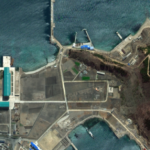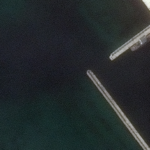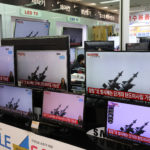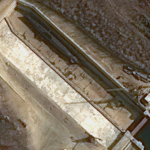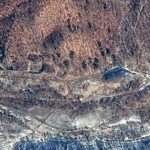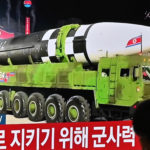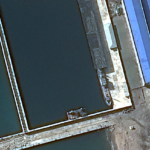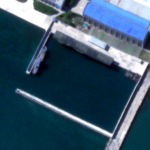April 8, 2021, by Joseph S. Bermudez Jr. and Victor Cha—
The recent repositioning of the submersible missile test stand barge was not an isolated event, but the latest in a series of small naval movements at the shipyard during the past several weeks. Satellite imagery of the Sinpo South Shipyard and its environs acquired on April 6 and 7, 2021 shows not only the recent movement of the submersible missile test stand barge, but also provides a general status update of the facility.
April 6, 2021, by Joseph S. Bermudez Jr., Victor Cha and Jennifer Jun—
A Maxar Technologies satellite image collected at 11:09 AM KST on April 6 shows that North Korea is moving its submersible missile test barge located at the Sinpo South Shipyard. As no missile canister is visible onboard the submersible missile test barge, this movement does not indicate an imminent SLBM test.
March 25, 2021, by Victor Cha—
“It’s business as usual” as North Korea appears to be resuming its cycle of provocations, using weapons demonstrations to build leverage and as a pressure tactic to force unilateral concessions from the United States for a return to the negotiating table.
March 19, 2021, by Joseph S. Bermudez Jr. and Victor Cha—
Minor activity is observed near the static test stand and the nearby Sinpo Shipyard’s graving dock in satellite imagery acquired on acquired on March 11, 2021. There are no indications of preparations of a forthcoming “pop-up” test of a submarine launched ballistic missiles (SLBM); however, the North could launch the new SSB or conduct additional SLBM tests at any time of its choosing.
February 18, 2021, by Joseph S. Bermudez Jr., Victor Cha and Jennifer Jun—
Commercial satellite imagery acquired on January 5, 2021 and February 7, 2021 indicate that the Yusang-ni missile base is operational and that minor development (i.e., construction, etc.) has continued since our last report from May 9, 2019... Commercial satellite imagery acquired on January 5, 2021 and February 7, 2021 indicate that the…
February 10, 2021, by Joseph S. Bermudez Jr. and Victor Cha—
There are no visible indications of preparations for the launch of the much anticipated “newly built submarine”—North Korea’s first true ballistic missile submarine (SSB). No significant activity is observed in satellite imagery of the Sinpo South Shipyard collected during the past several months. Typical of this is an image acquired on February 3, 2021.
December 24, 2020, by Joseph S. Bermudez Jr., Victor Cha and Dana Kim—
Located approximately 52 kilometers north of the DMZ and 125 kilometers north of Seoul, the Kal-gol missile operating base is one of the most developed of North Korea’s approximately 15-20 undeclared ballistic missile facilities. This base likely houses a reinforced brigade-sized unit equipped with 500-kilometer-range Hwasong-6 (Scud C) short-range ballistic missiles (SRBM) or Hwasong-9 (Scud-ER) medium-range ballistic missiles (MRBM).
November 5, 2020, by Markus V. Garlauskas—
If unchecked, North Korea is increasingly likely to resume strategic weapons testing in the months ahead—including tests of the technologies necessary for its missiles to carry multiple nuclear-capable reentry vehicles (RVs). Such missiles would, at a minimum, increase Pyongyang’s ability to challenge U.S. missile defenses, to make the most of its limited resources for strategic weapons production, and to threaten U.S. targets more credibly despite its limited flight testing of RVs.
October 29, 2020, by Joseph S. Bermudez Jr. and Victor Cha—
Latest observations of the Sinpo South Shipyard show a return to its status quo of low-level activity. Notable vessels and objects have returned to, or remain at, their usual positions. A satellite image of the Sinpo South Shipyard acquired on October 27, 2020 shows a return to what has become typical activity within the facility’s secure boat basin.
October 5, 2020, by Joseph S. Bermudez Jr. and Victor Cha—
With the upcoming Korean Workers’ Party Foundation Day celebration on October 10, a SLBM test should not be ruled out as a possibility for Kim Jong-un’s self-proclaimed “October surprise.” Such a test would be consistent with Beyond Parallel historical data that shows heightened provocations around U.S. presidential election years.
